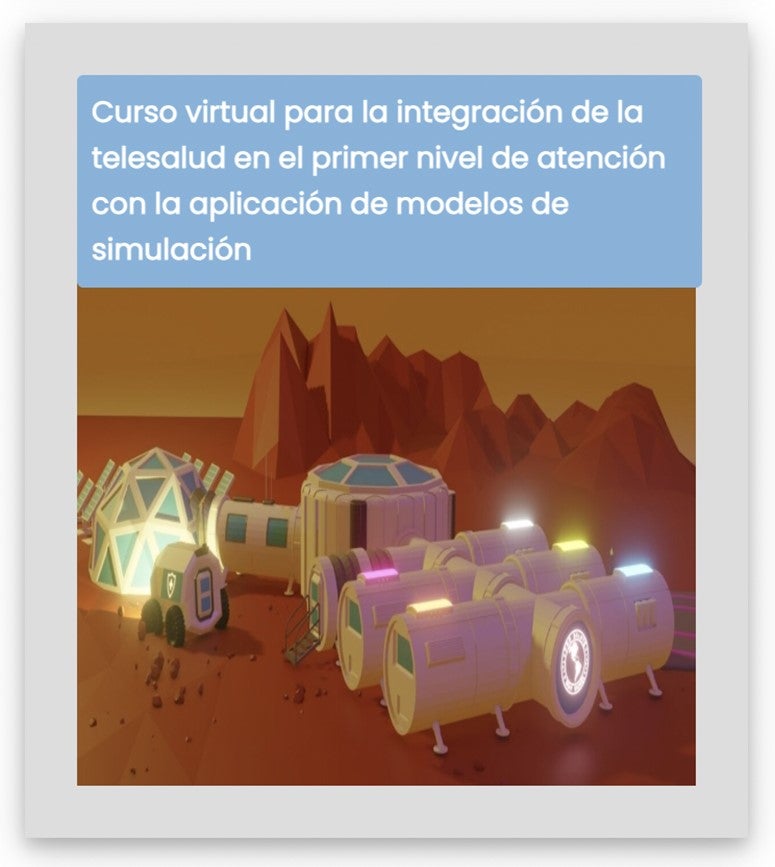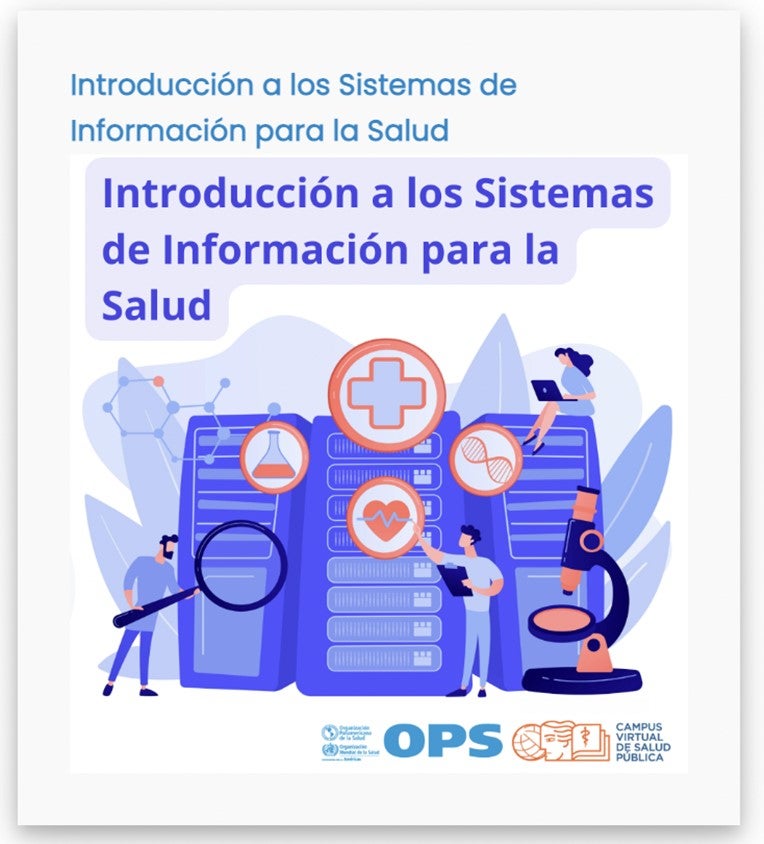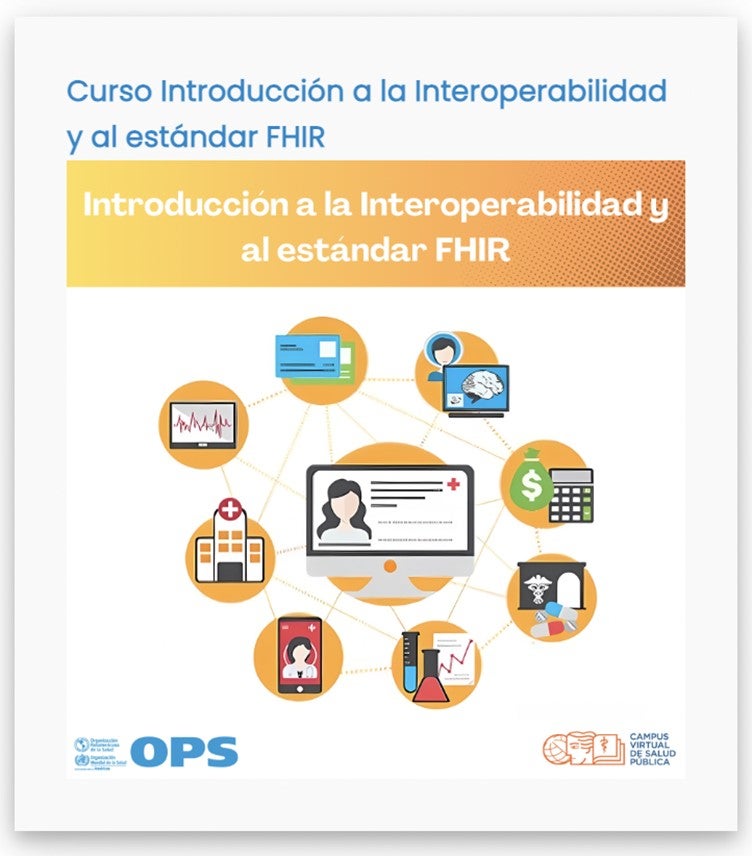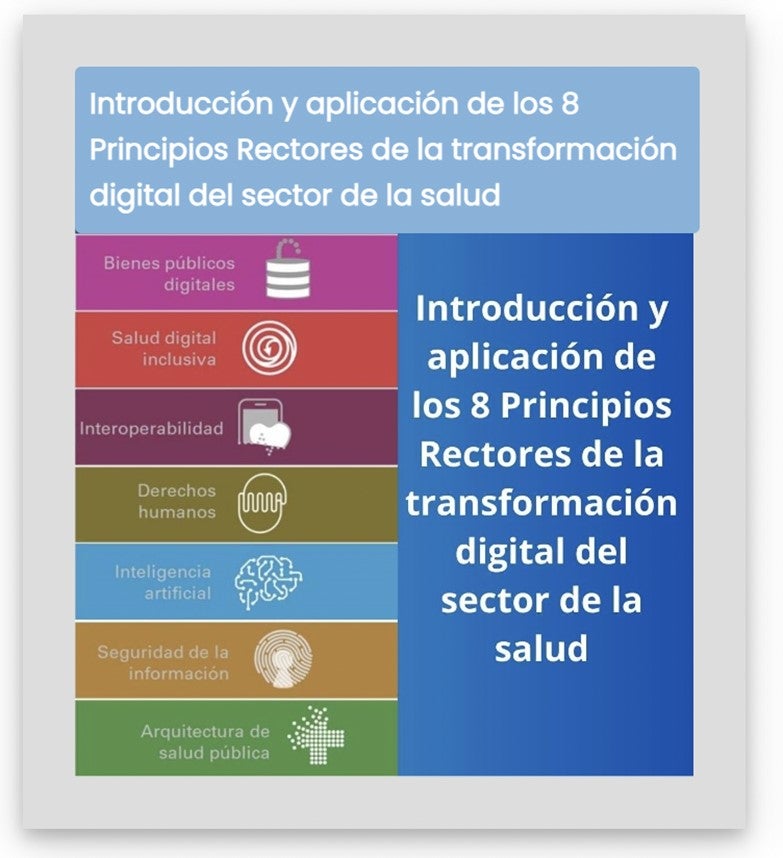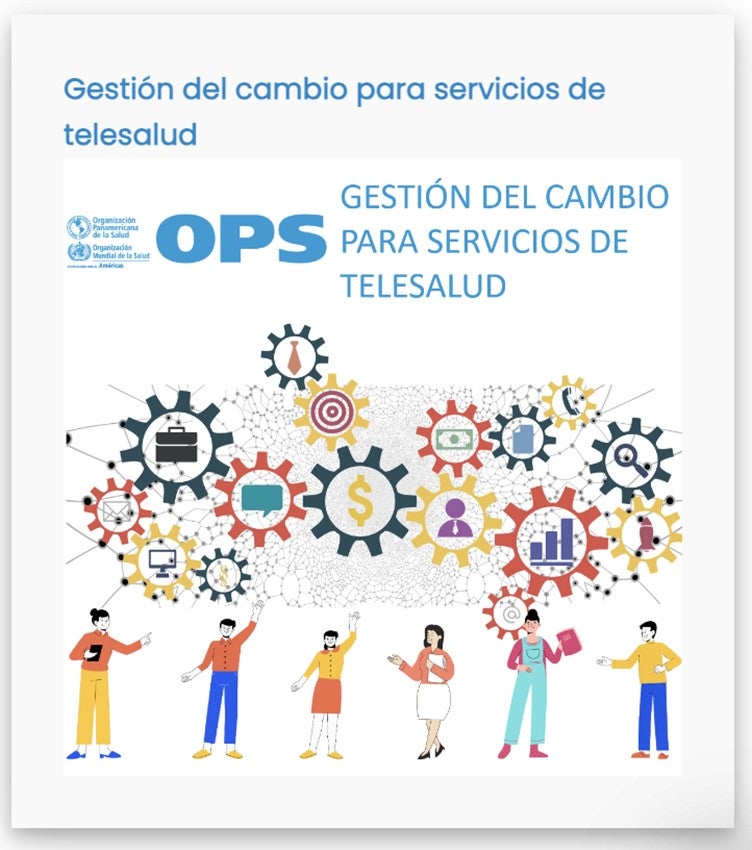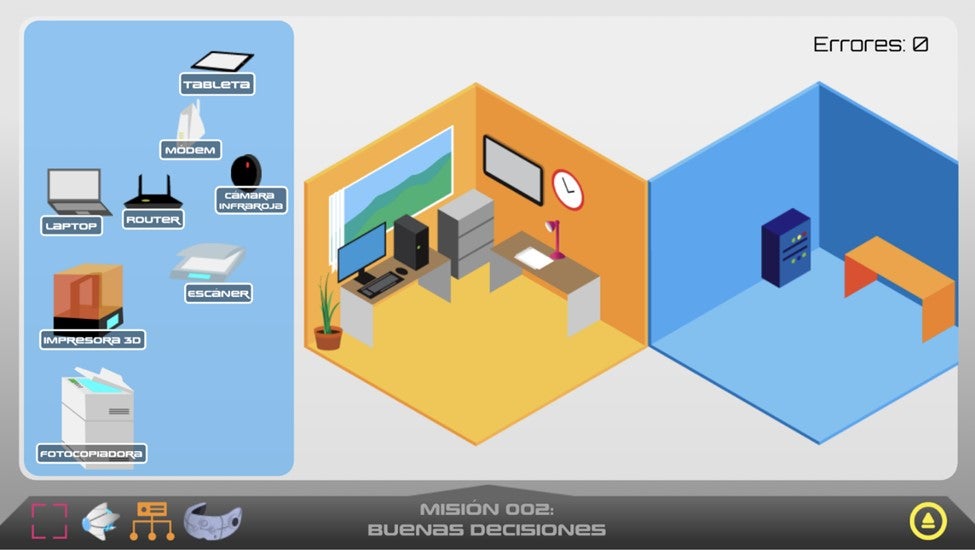Educational resources and academic journey by profiles
The new perspective that the COVID-19 pandemic has given us regarding the need to accelerate the digital transformation in the health sector and thus understand the importance of adopting telehealth services, has also generated the need to propose renewed strategies to promote not only their adoption and adaptation but also their appropriate, safe and effective use. From the latter arises the importance of designing a set of educational resources that involve generating new competencies from the lived experience (knowledge, skills and attitude) of health personnel and focused on people.
Description of the plan
The content of these resources is considered a comprehensive and integrated input of resources, with transversal characteristics, to facilitate the implementation of digital transformation programs in the countries of the Latin American and Caribbean Region. It is based on a series of actions designed with an innovative approach based on a simulation model that provides a controlled and trustworthy environment for the education-learning process of users.
This simulation model presents a renewed vision to respond to current demands linked to health services, proposes immersive tools and strategies that enable users to acquire the necessary knowledge to achieve the objective of expanding maturity and capabilities to carry out digital transformation processes in health. This plan contemplates in its scope the different types of users, that is, decision makers, health service providers, as well as recipients of the same (from the macro-management level to the micro-management level).
Methodological review
Simulation in the health field makes it possible to recreate environments, both non-clinical and clinical scenarios, designed to apply critical thinking, improve decision-making, as well as for training and guidance of procedures and skills.
Furthermore, based on the condition of health security and linked to the administration of human resources, a simulation model allows us to propose education-learning strategies for leadership, teamwork, problem solving and effective communication.
Through this simulation model, we aim to address different approaches in order to adapt the education-learning content.
In this way, PAHO then provides instruments for both training, education and learning of interventions in the field of digital health, as well as for technical learning.
The educational resources include the following training programs:
Virtual course for the integration of telehealth in the first level of care with the application of simulation models.
Introduction to Interoperability and FHIR standard.
Introduction to Health Information Systems.
Public health in the era of interdependence, eight guiding principles.
Digital transformation and interdependence in public health.
Change management as a critical success factor in the implementation of Telehealth services and programs.
Academic path by profiles
PAHO offers educational resources that cover most of the profiles related to the digital transformation process in the countries of the region.
The following table recommends some academic paths by profile, but since these are self-managed courses and are available on campus, they can be taken in any order and at the pace that each student considers.
→ Staff related to digital transformation processes in general
| |
→ IS4H implementers
| |
→ Telehealth program implementers
| |
→ Telehealth end users
| |
→ Junior technical staff in Interoperability
|
Description of the courses
• Introduction to Health Information Systems
Introduction
The purpose of this course is to provide an overview of the complexity of Information Systems for Health (IS4H), considering the functioning of the elements that compose them, through the analysis of their constituent dimensions. IS4H that interoperate in comprehensive care networks play an essential role in the health care of people throughout their lives, promoting access to timely health care, improving the quality, safety and cost effectiveness of health care.
As a line of action, the strengthening of Information Systems for Health promoted by the Pan American Health Organization, considers the training of human capital as a strategy to improve decision-making mechanisms, considering the exchange of knowledge and the adoption of knowledge management methodologies to support the implementation of IS4H.
The course provides opportunities to develop skills aimed at the effective application of Information Systems for Health.
Objectives
Upon completion of the course, participants will be able to:
Identify the main problems of health information that generate the main challenges when implementing health information systems.
Recognize the characteristics of information management and flow in the health institution and the main proposals to solve its deficiencies.
Describe the benefits of information technologies applied to the health field.
Recognize the strategic importance of using eHealth to support universal health coverage (UHC).
Describe the characteristics of health information systems from technological and functional perspectives.
Identify the impact of redesigning information systems to ensure the quality of medical care and continuous care, as well as to make the use of health resources more effective.
Target
The course is aimed at:
Officials involved in health decision-making.
Professionals and technical staff of the health team.
Modality
Free, open to the public, self-learning course with no deadlines for completion.
Duration
100 hours. The course is open access, since it is a self-learning course, participants can decide the time and moments they dedicate to completing it.
Link
https://campus.paho.org/es/curso/sistemas-informacion-salud
• Introduction to Interoperability and FHIR standard
Introduction
The purpose of this course is to provide an introductory and general overview of the essential concepts of interoperability, health standards and FHIR. Contemporary health information systems are made up of integrated healthcare networks that use standards to interoperate and manage all health information pertaining to the care and attention of people, originating in multiple sites and sources of information, within different organizations and/or health entities.
Currently, there is no single application that can solve all the needs related to the exchange of information, which is why it is necessary for the different systems to interoperate, avoiding task redundancy, reducing errors and increasing efficiency.
Objectives
Upon completion of the course, participants will be able to:
Understand the importance of interoperability in the field of health information systems
Define, explain and effectively use the concept of interoperability.
Recognize the benefits of achieving communication or interoperability between different health information systems.
Understand the importance of standards in the health field, as well as the problems that arise from the lack of these.
Identify different standards used in the health field, at local, regional and international level.
Know the HL7 standard, the vocabulary standards and their integration with clinical information systems, among others.
Identify the main characteristics of the FHIR standard, and the advantages in solving problems and limitations of other previous standards. Understand the concept of
FHIR resources and create them to interact with FHIR servers.
Recognize profiles, restrictions and the use of extensions.
Analyze the use of REST in FHIR documents, transactions and messages.
Target
The course is aimed at professionals and technical staff of the health team.
Modality
Self-learning course, free, open to the public and without deadlines to complete it.
Duration
120 hours. The course is free to attend, since it is a self-learning course, participants can decide the time and moments they dedicate to completing it.
Link
https://campus.paho.org/es/curso/interoperabilidad-fhir
• Public health in the era of interdependence, eight guiding principles
Introduction
The digitalization of health services involves important transformations and cultural changes for both society in general and health teams in particular.
The Pan American Health Organization, in collaboration with experts and actors in the region, developed a guide document on the 8 guiding principles for the digital transformation of the health sector with a holistic view of health information systems based on previous work and the regional diagnosis developed within the framework of health information systems and its 4 strategic areas and in response to the commitments made regarding digital transformation at the highest regional level and by the World Health Organization.
The eight guiding principles are intended to guide the countries of the Region of the Americas in the processes of digital health transformation. Their purpose is to support them in making informed decisions, formulating short- and long-term goals, and developing solid and sustainable public policies, leaving no one behind.
The purpose of this course is to contribute to the application of the 8 guiding principles for the digital transformation of the health sector at the national and subnational levels in the countries of the region, supporting the transformations and changes necessary to achieve health policies that favor the digitalization of health services in an inclusive manner.
The purpose of the course is to increase knowledge and provide tools for informed decision-making for the development of policies, programs and interventions that contribute to the digital transformation of the health sector in the Americas region through the application of the 8 guiding principles for the digital transformation of the health sector.
The course provides opportunities to develop skills related to the planning and implementation of quality, sustainable and inclusive digital health policies, as well as their monitoring.
Objectives
At the end of the course, participants will have acquired the knowledge and tools that will allow them to:
Know the key concepts related to the 8 guiding principles of the digital transformation of the health sector.
Examine the processes and the state of evolution of each of the principles in their scope of application.
Identify opportunities for improvement and intervention to advance each of the principles.
Apply knowledge and tools in decision-making regarding the development of policies, programs and interventions that lead to progress in health digitalization in a sustainable and inclusive manner.
Target
Decision-makers regarding the design, implementation and monitoring of health digitalization policies, programs and interventions.
Those responsible for policies, programs and processes related to health digitalization.
Members of PAHO and WHO departments and country offices.
Modality
Free, open-to-the-public, self-study course with no deadlines for completion.
Duration
25 (twenty-five) hours
It is estimated that participants should spend three hours per main training module to watch the videos, review the reading materials and resources, and complete the evaluation activities.
Since it is a self-learning course, participants can decide the time and moments of dedication to it.
Link
https://campus.paho.org/es/curso/salud-digital-8-principios
• Virtual course for the integration of telehealth in the first level of care with the application of simulation models
Introduction
The Telehealth Training Center is an initiative of the Pan American Health Organization whose main purpose is to integrate telehealth at the first level of care, in order to promote and contribute to the necessary digital transformation in the Region of the Americas. The focus of the training center's activities is linked to the prevention, promotion, diagnosis, monitoring and treatment of non-communicable diseases.
It consists of a professional development program to support the creation of resilient health systems in the post-pandemic era, created from various learning environments, and scalable for the continuous training of health personnel in the Region of the Americas in Telehealth, under the E-learning modality.
It is designed in a playful way and is based on the competency-based approach, seeking not only to transfer knowledge, but to develop know-how (skills) and, above all, to reinforce know-how, mobilizing the necessary attitudes and associated fundamental competencies.
As it is adult education, innovative methodologies are taken into account that favor the teaching-learning process, including andragogy, didactics for adults, and mental training, considering an adequate balance of multimedia and interactivity.
The Telehealth training center seeks that, upon completion, the participant will be able to integrate telehealth in the first level of care, to facilitate prevention, promotion, diagnosis, monitoring and treatment actions of non-communicable diseases.
Objectives
Upon completion of the training center activities, participants will be trained to:
Explain the functions of telehealth and benefits for a better understanding of its operation at the first level of care.
Identify the basic organizational and technological structure for the operation of the telehealth service at the first level of care.
Recognize teleconsultations as an essential element for the implementation of telehealth at the first level of care.
Identify digital tools associated with teleconsultations as fundamental axes for the implementation of telehealth at the first level of care
Identify the main types of teleconsultations for a better understanding of the functioning of telehealth at the first level of care.
Describe the normative, ethical, and communication regulations necessary for the operation of telehealth at the first level of care.
Explain the main barriers that telehealth faces at the first level of care to facilitate the operation of services.
Distinguish good from bad practices in telehealth in order to promote the provision of efficient and quality services.
Place the learning in the prevention, promotion, diagnosis, monitoring, and treatment of non-communicable diseases.
Simulation: equipment of the point of attention.
Target
The training center is aimed at health sector workers in the Region of the Americas who do not have prior knowledge of telehealth and who are interested in learning and training about its potential.
Modality
Self-learning course, free, open to the public and without deadlines to complete it.
Duration
Forty (40) hours.
The training center is free access, since it is a self-learning space. Participants can decide the time and moments they dedicate to doing it.
Link
• Digital transformation and interdependence in public health
Introduction
Digital transformation for health means positioning public health at the forefront of the era of digital interdependence. Interdependence between stakeholders becomes essential in the digital era, given that no entity or person has all the necessary resources, whether knowledge, creativity, financial or technological. Therefore, collaboration, coordination and co-creation are critical factors for success.
A holistic approach and renewed knowledge and skills are needed at the managerial levels of public health. It is expected that at the end of the training, participants will be able to transmit and apply the theoretical concepts in their daily work. At the end of the course, participants will be able to strengthen their managerial activities through the effective use of information technologies and data management.
The purpose of the course is that those who take it, in addition to developing skills in digital health, are able to design a virtual course on the CVSP platform to implement actions that allow the inclusion of ICT in the field of public health for the improvement of services.
Objectives
Analyze digital transformation for professional practice in the era of interdependence.
Implement actions that allow the inclusion of ICT in the field of public health for the improvement of services.
Analyze digital transformation, to implement it in health sector interventions.
Identify multisectoral and interdisciplinary work between the health and information and communications technology sectors.
Analyze the applications of Artificial Intelligence (AI) and other emerging technologies in healthcare, public health, and global health throughout the healthcare system and beyond.
Analyze the characteristics of information systems within various types of organizations to differentiate their components.
Identify the importance of accepting and assimilating new concepts associated with data management in the digital age.
Analyze actions to combat the infodemic during public health emergencies or in actions of national interest such as vaccination campaigns.
Identify where and how to search for health information effectively and safely.
Analyze the positive and negative impacts that different levels of openness in public health could have.
Analyze remote organizational culture and practices.
Analyze strategies that can be executed in an effective and efficient manner to manage remotely.
Identify the concepts associated with digital diplomacy issues in an interconnected society.
Target
The target population will be:
PAHO/WHO managers and decision-makers
Modality
Virtual, competency-based Self-managed, Available 24/7, Sequential Interactive with instant feedback.
Duration
12 hours
Link
In progress
• Change management as a critical success factor in the implementation of Telehealth services and programs
Introduction
The Americas region is undergoing a process of rapid adoption of telehealth service models, motivated by the need to provide and expand services in the context of COVID-19, as well as by the opportunities derived from the investment made by the States and the contributions of international cooperation, including PAHO. In this new technological and health scenario within health systems, it is critical to advance in the creation and strengthening of capacities of health teams that must design, plan, execute and evaluate care processes that use information and communication technologies (ICT).
These actions require knowledge and change management skills that allow them to lead digital transformation processes to align them with the health objectives and principles agreed upon by the countries within the framework of PAHO. Change management involves the ability to understand and intervene appropriately in the collective processes that individuals go through, facilitating dialogue and effective action that guides digital transformation towards agreed needs and priorities, anticipating, preventing and addressing difficulties, as well as celebrating achievements.
Objective
To create change management capabilities in health teams to adopt information and communication technologies in order to initiate or enhance telehealth services, particularly in the prevention and treatment of non-communicable diseases, including mental health.
Target
Health personnel in the Americas, from all disciplines and profiles linked to the health field, interested in acquiring change management tools.
Those in charge of implementing or managing telehealth projects, with the task of implementing or optimizing telecare services, with an emphasis on non-communicable diseases, including mental health.
Members of health teams, who act as change agents or need change management tools to support telehealth projects and services.
Modality
Asynchronous, self-administered online course.
Duration

